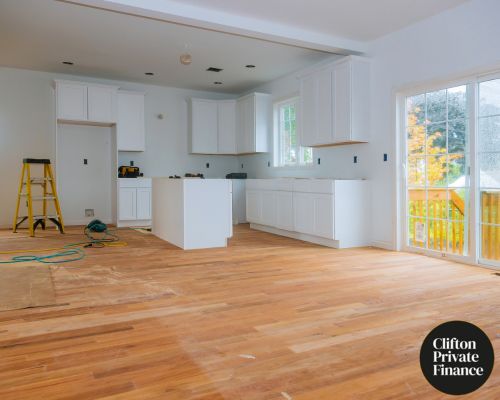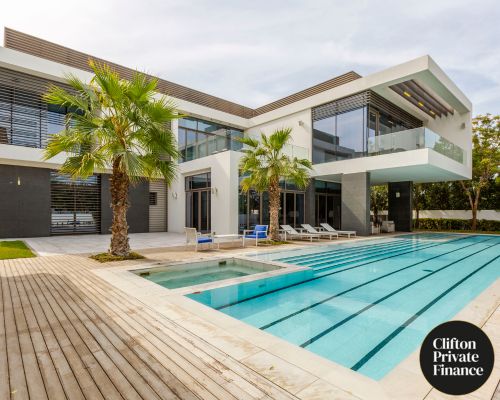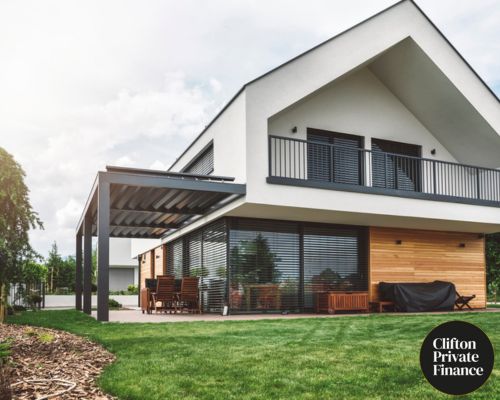
Refurbishment Finance


Read our guide to property refurbishment loans here
Finance Rates from 1 - 18 months Rates up to 80% LTV net As at 20th June 2023 Finance Rates from Up to 24 months Rates up to 70% of GDV As at 20th June 2023 Finance Rates from 1 to 18 months Rates up to 80% LTV net As at 20th June 2023 Thank You for your interest - please complete the form below and a member of our team will be in contact.Flipping Property?
Buying, Renovating & Selling (or Letting)
0.55% pm
Ground Up Development
New Builds
0.83% pm
Existing Development?
Refinance & Exit Finance
0.55% pm
Contact Us






If you need property refurbishment finance, there are several good reasons to using our service:
Clifton Private Finance is a UK-based, FCA regulated property development finance specialist broker.
Thanks to our established relationships with property refurbishment finance lenders across the market, we can quickly find you the best deals currently available, no matter what kind of refurbishment project you are undertaking.
Finance Rates from 1 - 18 months Rates up to 80% LTV net As at 20th June 2023 Finance Rates from Up to 24 months Rates up to 70% of GDV As at 20th June 2023 Finance Rates from 1 to 18 months Rates up to 80% LTV net As at 20th June 2023 Thank You for your interest - please complete the form below and a member of our team will be in contact.Flipping Property?
Buying, Renovating & Selling (or Letting)
0.55% pm
Ground Up Development
New Builds
0.83% pm
Existing Development?
Refinance & Exit Finance
0.55% pm
Contact Us
I approached Clifton Private Finance to help me get a mortgage as an Expat working in the Far East. I would normally 'cut out the middle man' on something like this and try to get myself a deal directly with the banks, but I am now sold on the broker concept and wouldn't hesitate to use Clifton Private Finance again. There were a number of complicating factors such as being an expat, the stamp duty holiday, the sheer amount I wanted to borrow and the fact I wanted it all wrapped up before the Stamp Duty holiday ended. It is clear to me now that the relationship that brokers have managed to foster with their banks means they can simply pull levers and make stuff happen that us ordinary folk cannot. Put simply, they are worth every penny, will take most of the stress out of the lending process, and seem to have access to deals that you just won't find on the internet. Thank you George and Jan for all your hard work!
James M
Luther was excellent. Very clear in his advice and explanations of products and was able to move things on very quickly when we ran into difficulties with the estate agents. Without a doubt I would recommend Luther to all friends, family and colleagues. Luther was a joy to deal with and took a lot of the stress out of a troublesome transaction, from my end. I would view Luther as real asset to Clifton Private Finance Ltd.
William W
The team at Clifton Private Finance has been outstanding, not only in helping me to obtain a mortgage on a slightly unusual home, but also in continuing to provide support and liaise with the lender and solicitors through to completion. Thank you for making the process of buying my first home much easier.
Chantelle S
Sam O'Neill, and the new lender he identified for me, worked tirelessly together using my time constraints, to make sure my mortgage application was completed on time. They are a brilliant company to work with, fast, efficient, open and transparent from the very beginning, and turned a seemingly impossible situation into a viable one. Sam was brilliant throughout the whole process and I would highly recommend him, and his colleague Helen, to anyone without hesitation, I cannot speak highly enough about them.
Myr B
I was incredibly lucky to find Clifton Private Finance after a search on line as their service has been more than exemplary. My point of contact was Sam 0’Neill and he was happy to help at every stage during the application of the bridging loan, making a stressful process much easier to deal with. He was always available by phone or email and gave prompt answers to queries I had as well as always getting back to me when he said he would. That to me is excellent customer service and I cannot thank him personally or the company enough for the support they have given me.
C Jefferey
Adam cannot thank you enough for all your support throughout this arrangement. You have gone more than the extra mile to support us. Without you we would not have got our dream retirement home. You have been most professional and personable. Liz and I would be more than happy if you wanted to use us a reference with respect to any future clients.
Nigel & Liz K - Bristol
You have certainly shown me that you do everything for your clients, including tolerating their excessive emails and questions for updates. I have been kept in the loop, from yourself, about why the delays were occurring (Nationwide, post etc) which I would like to highlight that I really appreciated. I certainly will be able to recommend you to others as and when the need arises.
Mr Morris
I recently contacted Clifton Private Finance after a Google search for bridging finance providers and was immediately struck by their efficiency and support. Forms were emailed over almost immediately and the necessary finance was arranged within a few days. None of the other companies I contacted came close to their professionalism, and the quote that I eventually received was impressive. Thank you Adam, your help has enabled us to reserve the house that we wanted and I certainly recommend you to others.
Mr M. R. - Oxford
Absolutely brilliant. The service was first class, got everything sorted efficiently and were always friendly. Any fees were negligible compared to the service offered. Robert was particularly outstanding.
Charles N
My advisor, Robert, was very helpful in finding the mortgage to suit me. He kept me up to date throughout the process and dealt with any issues when they arose.
Rowena C